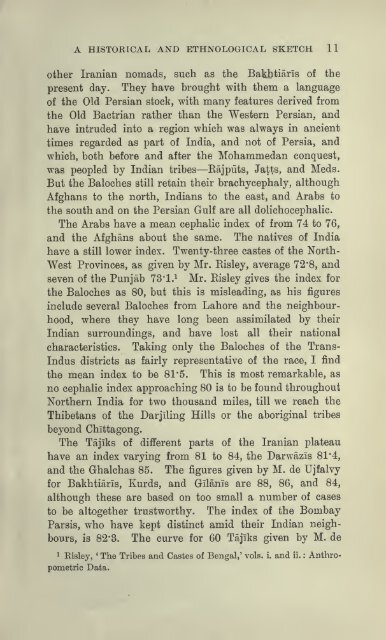You also want an ePaper? Increase the reach of your titles
YUMPU automatically turns print PDFs into web optimized ePapers that Google loves.
A HISTORICAL AND ETHNOLOGICAL SKETCH 11<br />
other Iranian nomads, such as the Bakhtiarls of the<br />
present day. They have brought with them a language<br />
of the Old Persian stock, with many features derived from<br />
the Old Bactrian rather than the Western Persian, and<br />
have intruded into a region which was always in ancient<br />
times regarded as part of India, and not of Persia, and<br />
which, both before and after the Mohammedan conquest,<br />
was peopled by Indian tribes—Bajputs, Jatts, and Meds.<br />
But the Baloches still retain their brachycephaly, although<br />
Afghans to the north, Indians to the east, and Arabs to<br />
the south and on the Persian Gulf are all dolichocephalic.<br />
The Arabs have a mean cephalic index of from 74 to 76,<br />
and the Afghans about the same. The natives of India<br />
have a still lower index. Twenty-three castes of the North-<br />
West Provinces, as given by Mr. Eisley, average 72*8, and<br />
seven of the Punjab 73 'l. 1 Mr. Bisley gives the index for<br />
the Baloches as 80, but this is misleading, as his figures<br />
include several Baloches from Lahore and the neighbour-<br />
hood, where they have long been assimilated by their<br />
Indian surroundings, and have lost all their national<br />
characteristics. Taking only the Baloches of the Trans-<br />
Indus districts as fairly representative of the race, I find<br />
the mean index to be 81*5. This is most remarkable, as<br />
no cephalic index approaching 80 is to be found throughout<br />
Northern India for two thousand miles, till we reach the<br />
Thibetans of the Darjlling Hills or the aboriginal tribes<br />
beyond Chittagong.<br />
The Tajiks of different parts of the Iranian plateau<br />
have an index varying from 81 to 84, the Darwazis 81*4,<br />
and the Ghalchas 85. The figures given by M. de Ujfalvy<br />
for Bakhtiarls, Kurds, and Gilanis are 88, 86, and 84,<br />
although these are based on too small a number of cases<br />
to be altogether trustworthy. The index of the Bombay<br />
Parsis, who have kept distinct amid their Indian neigh-<br />
bours, is 82-3. The curve for 60 Tajiks given by M. de<br />
1 Kisley, The Tribes and Castes of Bengal,' vols. i. and ii. : Anthro-<br />
pometric Data.


